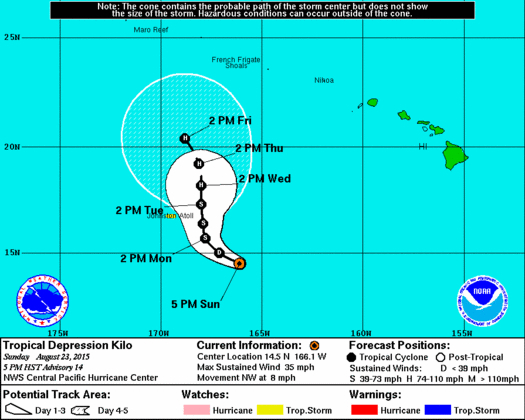Flash flood watches and warnings cropped up around the Big Island and the state on Sunday due to a mass of saturated air drawn along with Tropical Depression Kilo. The unstable air mass brought thunderstorms, sudden gusts, stifling heat and
Flash flood watches and warnings cropped up around the Big Island and the state on Sunday due to a mass of saturated air drawn along with Tropical Depression Kilo. The unstable air mass brought thunderstorms, sudden gusts, stifling heat and sudden downpours. The South Kohala and North Kona region from Waikoloa to Kailua-Kona was under flash flood warning Saturday evening as dark clouds dumped rain at a rate of 4 to 6 inches and hour around Waikoloa, according to National Weather Service estimates using radar.
A marine weather statement warned mariners of dangerous lightning and to be prepared for zero visibility in places due to intense downpours.
Although Kilo is still predicted to build into a hurricane, the forecast course of the storm has moved west, taking major effects away from the main Hawaiian Islands.
Kilo was 750 miles west-southwest of the Big Island, traveling west-northwest at 8 mph, and had not strengthened Sunday evening beyond the 35 mph winds it was packing Friday and Saturday. The storm is expected to begin a more northwesterly turn on Monday, then bend gradually around to the northeast and slow to a crawl as steering currents weaken. By Thursday, however, the track veers to the northwest, taking the system off on a roughly parallel course with Northwest Hawaiian Islands chain, but well to the south of it.
Kilo is moving into an area of weaker shear and warm water, and gradual intensification has the system growing into tropical storm by Monday and a Category 1 hurricane with 90 mph winds by Friday.
The forecast track continued to shift west on Sunday, taking the projected course of the storm several hundred miles away from Kauai. A tropical storm watch has been issued for Johnston Atoll, with storm conditions possible across the atoll starting Monday as the center passes over 100 miles to its east.




